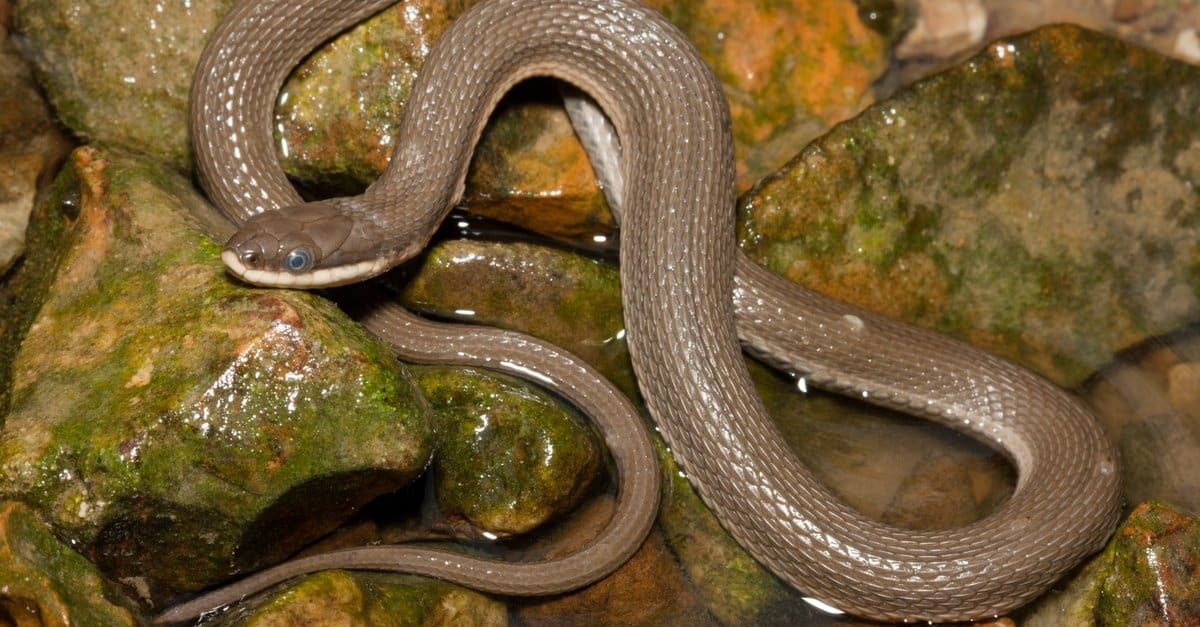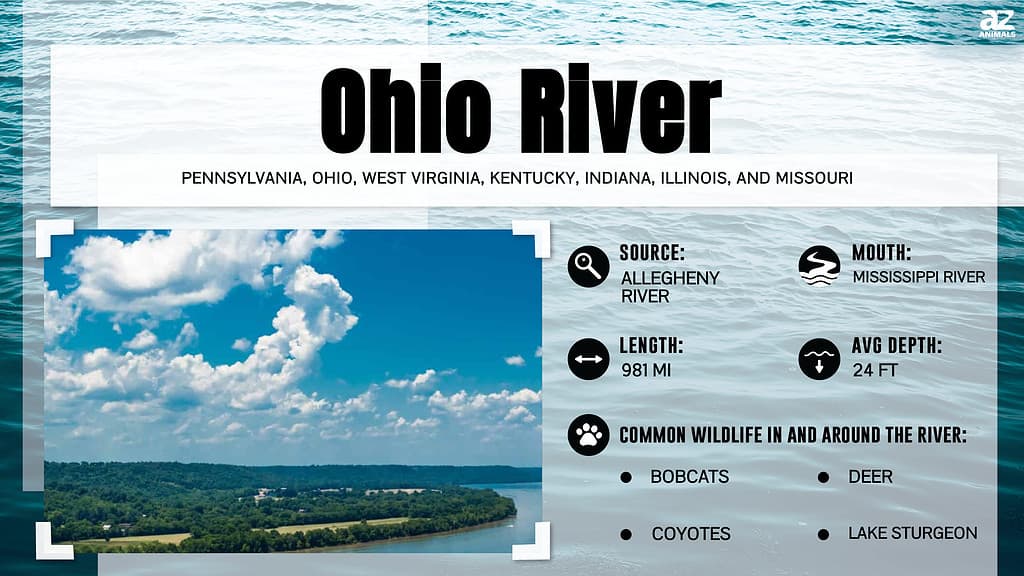
Love or hate them, snakes are definitely one of the more popular animal species, and without a doubt, the Ohio River has its fair share of slithering reptiles. The Ohio River is 981 miles long, making it the 10th longest American river. It runs through Ohio, Pennsylvania, West Virginia, Kentucky, Indiana, and Illinois.
This waterway holds great significance to everyone and everything that lives near it. In recent years, the states that share the river basin have joined forces to take on the challenge of restoring and protecting this crucial ecosystem.
The Ohio River supplies drinking water to over 5 million people. It also serves as a habitat for the slithering reptiles in this list as well as a vibrant community of aquatic birds, small mammals, and over 160 species of fish.
Ever wondered just how many snake species you could come across if you swam the entire Ohio River? This article has got you covered. Meet the 6 snakes of the Ohio River.

1. Ribbonsnake (Thamnophis saurita)
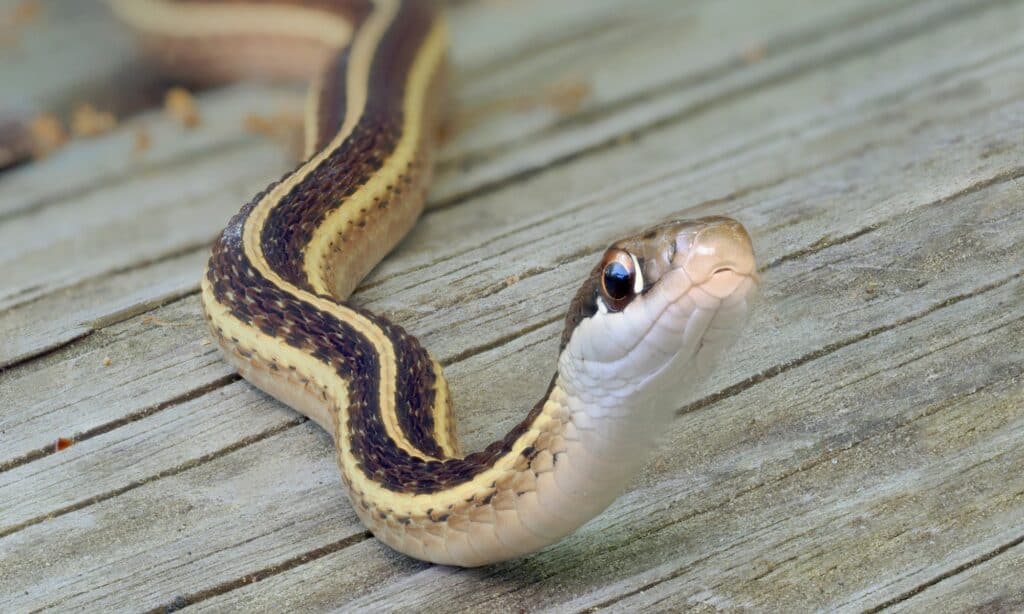
Unlike most snakes, ribbon snakes have pretty good eyesight.
©iStock.com/sdbower
Ribbon snakes are small, nonvenomous colubrid snakes commonly found in many states in the US. On average, they measure 16 to 35 inches long and can either be dark brown or black with bright yellow stripes or white stripes which run along their sides and backs.
They may have blackheads and white or yellow bellies. Ribbon snakes are classified as garter snakes which are harmless and small-sized.
Unlike most snakes, ribbon snakes have pretty good eyesight, so they don’t rely only on their tongue and Jacobson’s organ when they hunt. Instead, their eyesight, as well as their natural sensitivity to vibrations, helps them prey on small fishes, salamanders, newts, and tadpoles that live in or close to the river.
Ribbon snakes also prey on spiders, earthworms, caterpillars, and a large number of insects.
2. Northern Water Snake (Nerodia sipedon)
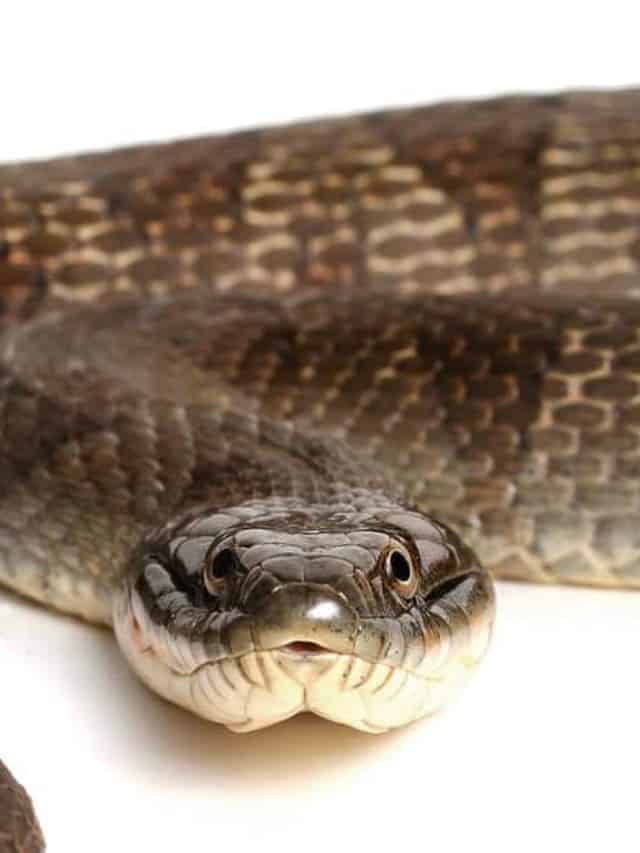
On average, northern water snakes measure up to 4.5 feet long.
©Michiel de Wit/Shutterstock.com
Northern water snakes are non-venomous colubrid snakes found in Ohio’s waters. On average, they measure 4.5 feet long and weigh up to 19.8 ounces (1.2 pounds).
They are much larger than the average garter snake and don’t seem to have the appearance of harmlessness that garter snakes’ usual small sizes give them.
Worse still, they are dark snakes with dark blotches that cover their bodies and dark crossbands across their neck, features that they share with the more venomous cottonmouth snake.
Although cottonmouths are shorter and much larger than watersnakes, many people do not wait to double-check before killing these harmless animals for fear of their “venom,” which is non-existent. However, northern water snakes do not make it easy on their attackers and react violently and frantically when picked up.
Not only will they release musk, but they also bite repeatedly even though they have no venom.
3. Copper-Bellied Water Snake (Nerodia erythrogaster neglecta)
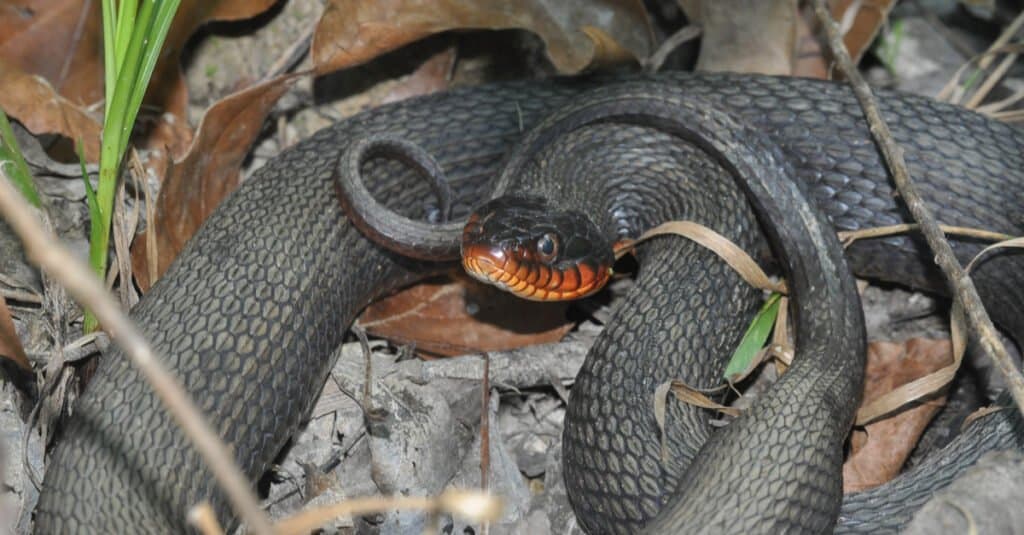
Adult copper-bellied water snakes also have a two-toned crossband pattern, copper chins, and lips.
©Mike Wilhelm/Shutterstock.com
Copper-bellied water snakes are deep-brown or bluish-black snakes with bright orange or copper bellies. They are lengthy and non-venomous colubrids that grow up to 65.5 inches (5.5 feet).
Baby copper-bellied snakes measure 6 inches at birth, and by their first year, they are triple that length. Adults also have a two-toned crossband pattern, copper chins, and lips which are key features that can help set the species aside from others.
As a result of their unique colors, these snakes are overhunted. However, it isn’t easy to catch one because they are rare, reclusive, and secretive. Due to how frequently they have hunted as well as the loss of habitat, they are a threatened species in the state of Ohio.
4. Eastern Fox Snake (Pantherophis gloydi)

The Eastern fox snake mimics a rattlesnake by shaking its tail like it has a rattle.
©Ryan M. Bolton/Shutterstock.com
Eastern fox snakes are nonvenomous rat snakes found in Ohio’s marshes and wetlands. Like all rat snakes, eastern fox snakes often mimic venomous rattlesnakes by shaking their tails as rattles. They are medium-sized snakes and measure from 35.8 to 54.0 inches (3.0 to 4.5 feet). Juvenile snakes have a tan color patterned with deep brown spots.
Adult eastern fox snakes have tan to pale-yellow background skin with dark blotches, which could be black or deep brown. They also have vertical black bands that spread across their tails. Both adults and juveniles have yellow bellies checked with black spots. Fox snakes feed on small birds, rats, and other small mammals. Despite being nonvenomous, these snakes do not hesitate to bite if threatened and violently defend themselves against predators.
5. Ohio Valley Water Snake (Clonophis kirtlandii)
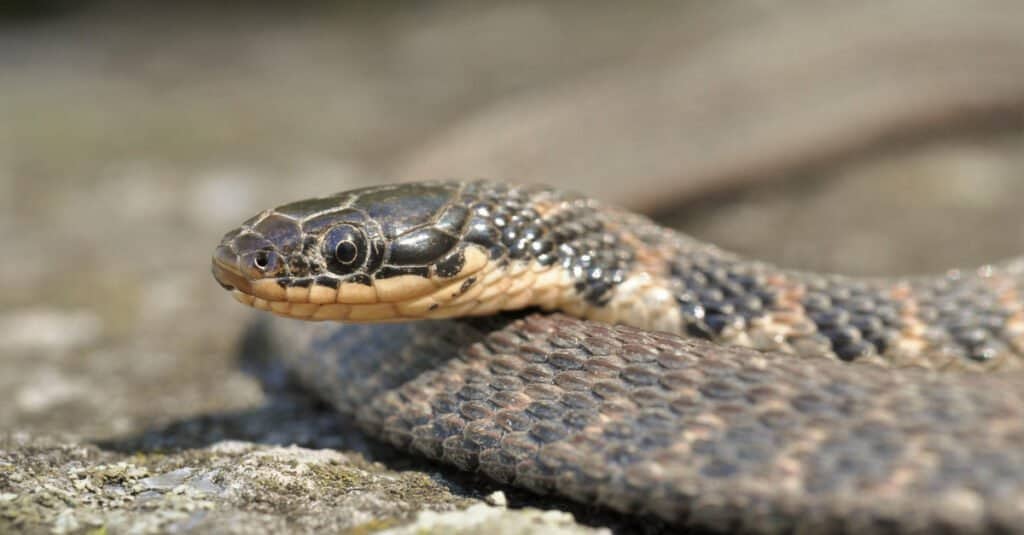
Kirtland’s snake is a threatened snake species inhabiting the Ohio River valley.
©Mike Wilhelm/Shutterstock.com
The Ohio Valley water snake, also known as Kirtland’s snake, is another threatened snake species found in the Ohio River. It is a nonvenomous colubrid water snake found in only a few American States. On average, these snakes measure 14-28 inches and have grayish-brown to black scales with large black spots that run down their bodies in groups of two. They also have smaller spots along their sides.
Although Ohio Valley water snakes aren’t always found in water, they are never too far from it and are commonly found in forests, wetlands, and marshes. One fun fact about the species is that no human on record has ever been bitten by one. They are known to adopt aggressive stances, hide, and run instead of engaging in fights of any kind.
6. Queen Snake (Regina septemvittata)
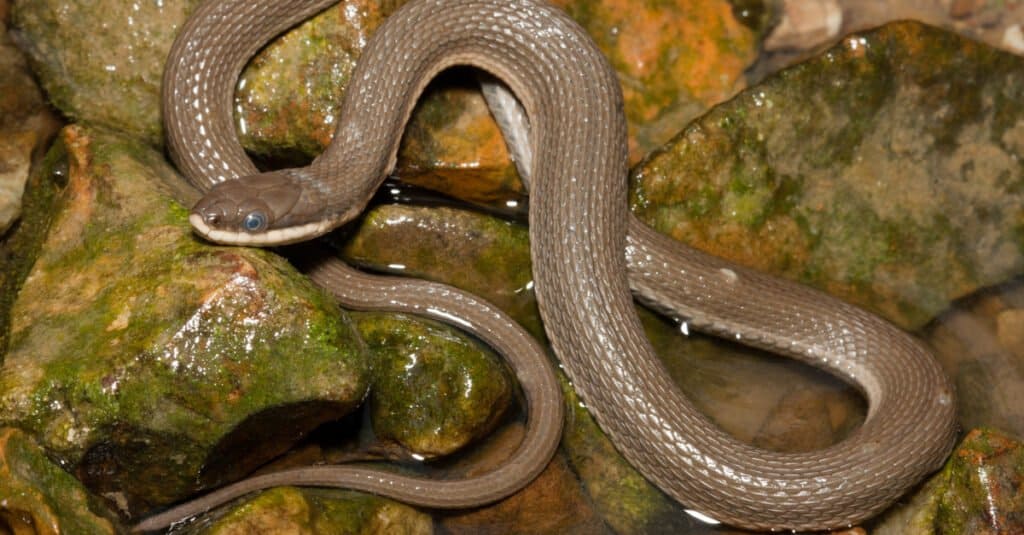
The queen snake has dark brown, olive, or gray ventral scales with peach or yellow stripes that trail down the first scale row.
©Nathan A Shepard/Shutterstock.com
Queen snakes are nonvenomous semi-aquatic snakes that are quite picky about their habitats. They are never found in areas without rocky bottoms, watersheds, and clean running streams with a minimum temperature of 50 degrees Fahrenheit.
Queen snakes are also picky eaters and feed mostly on freshwater crayfish. They have dark brown, olive, or gray ventral scales with peach or yellow stripes that trail down the first scale row. They also have 4 darker-colored ventral stripes and a cream or yellow belly. Queen snakes grow to a maximum of 24 inches (2 feet).
Animals that Live Along the Ohio River
The Ohio River is one of the most important waterways in the United States, flowing over 981 miles through six states. Along its banks and in the surrounding area, there is a wide variety of wildlife that call this region home.
Here are a few examples of some of the animals that live along the Ohio River:
- Bald Eagles: The Ohio River is a popular spot for bald eagles, which can be seen soaring overhead and perching in trees along the riverbanks. These majestic birds of prey are a symbol of freedom and are protected under federal law.
- White-tailed Deer: White-tailed deer are a common sight along the Ohio River, and they can often be seen grazing in meadows and along the riverbanks. These graceful animals are popular game animals and are also an important part of the ecosystem.
- River Otters: River otters are semi-aquatic mammals that are found along the Ohio River and its tributaries. These playful animals are excellent swimmers and divers, and they can often be seen playing in the water or hunting for fish and other aquatic prey.
- Common Carp: The Ohio River is home to a wide variety of fish species, but one of the most common is the common carp. These large, bottom-dwelling fish can grow up to three feet in length and are often caught by anglers fishing along the riverbanks.
These are just a few examples of the many animals that can be found along the Ohio River. From birds and mammals to fish and reptiles, this region is home to a diverse array of wildlife that is well worth exploring and appreciating.
Is It Safe To Swim In The Ohio River?
Certain parts of the Ohio River are safe to swim in. According to the Ohio River Valley Water Sanitation Commission (ORSANCO), some parts of the river pose a level of risk to human health due to the condition of the water. It is important to swim only in places marked as safe by the authorities.
What Happens If You See a Snake Under Water?
Seeing a snake underwater is very unlikely as they will sense you and do everything to stay away from you. However, if you do see one, stay calm and make light movements in the water without being aggressive. The snake will most likely swim away. Snakes are just as wary of humans as we are of them and will not willingly cross paths with you.
Discover the "Monster" Snake 5X Bigger than an Anaconda
Every day A-Z Animals sends out some of the most incredible facts in the world from our free newsletter. Want to discover the 10 most beautiful snakes in the world, a "snake island" where you're never more than 3 feet from danger, or a "monster" snake 5X larger than an anaconda? Then sign up right now and you'll start receiving our daily newsletter absolutely free.
Thank you for reading! Have some feedback for us? Contact the AZ Animals editorial team.

